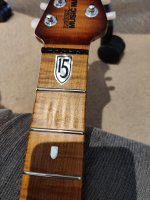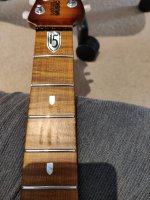gurtejsingh
Well-known member
Fellow ballers! Hope you all are doing great! Calling all the experts for some help regarding my JP15's roasted maple fretboard. I am usually quite regular with changing strings and cleaning the fretboard, but this time I think I changed them after a while (4-5 months of regular home playing) and I noticed these weird marks on the Fretboard which wont go away and are only visible under a certain angle in the light (please see attached pics, I have tried my best to capture it, it's not easy).
Like always, I cleaned the fretboard with Wonder Wipes, and applied a quick clean of Lemon oil, but still these won't go away. and I have never seen these marks before and I have had this guitar for over 5 years now and I regularly take care of it.
Is it that the fretboard is drying up in those areas (I am in Australia)? Or is it just guitar mojo that comes with age and me getting wiser ?
?
It does not affect the playability in any way and is only visible under a specific angle. I just want to take care of it and fix it and perhaps not let it grow more.
Really appreciate all the help! Cheers.


Like always, I cleaned the fretboard with Wonder Wipes, and applied a quick clean of Lemon oil, but still these won't go away. and I have never seen these marks before and I have had this guitar for over 5 years now and I regularly take care of it.
Is it that the fretboard is drying up in those areas (I am in Australia)? Or is it just guitar mojo that comes with age and me getting wiser
It does not affect the playability in any way and is only visible under a specific angle. I just want to take care of it and fix it and perhaps not let it grow more.
Really appreciate all the help! Cheers.




